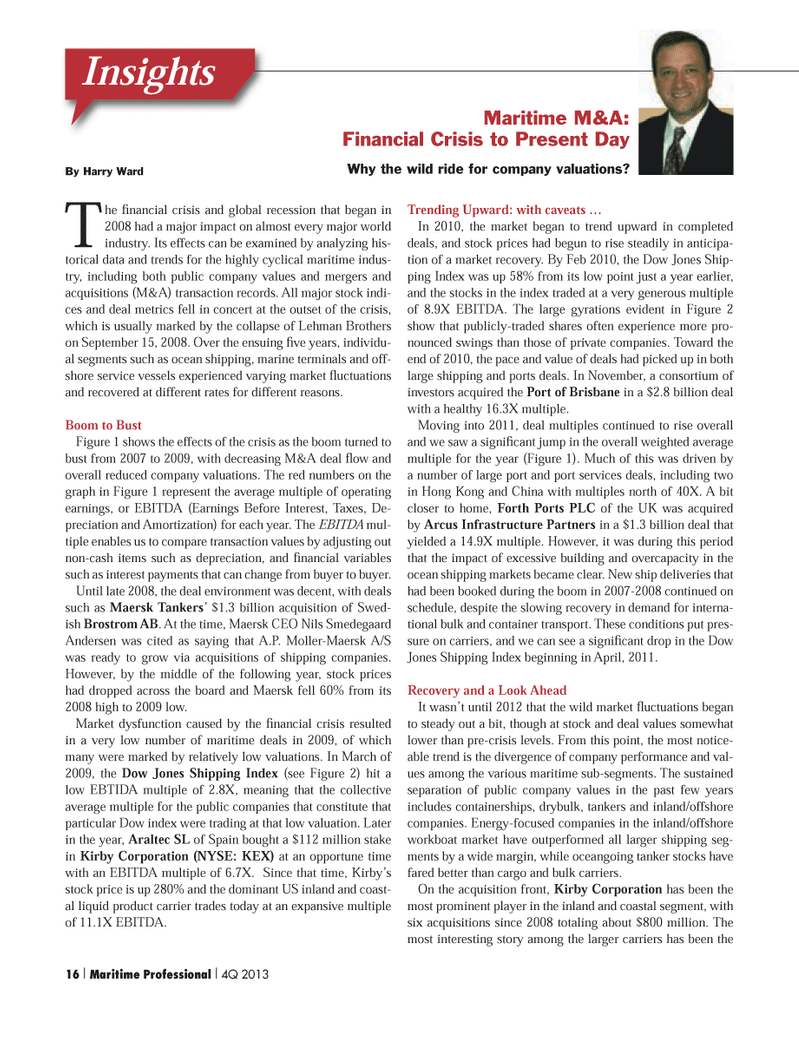
Page 16: of Maritime Logistics Professional Magazine (Q4 2013)
Shipbuilding, Repair
Read this page in Pdf, Flash or Html5 edition of Q4 2013 Maritime Logistics Professional Magazine
The Þ nancial crisis and global recession that began in 2008 had a major impact on almost every major world industry. Its effects can be examined by analyzing his- torical data and trends for the highly cyclical maritime indus- try, including both public company values and mergers and acquisitions (M&A) transaction records. All major stock indi- ces and deal metrics fell in concert at the outset of the crisis, which is usually marked by the collapse of Lehman Brothers on September 15, 2008. Over the ensuing Þ ve years, individu- al segments such as ocean shipping, marine terminals and off- shore service vessels experienced varying market ß uctuations and recovered at different rates for different reasons. Boom to BustFigure 1 shows the effects of the crisis as the boom turned to bust from 2007 to 2009, with decreasing M&A deal ß ow and overall reduced company valuations. The red numbers on the graph in Figure 1 represent the average multiple of operating earnings, or EBITDA (Earnings Before Interest, Taxes, De- preciation and Amortization) for each year. The EBITDA mul-tiple enables us to compare transaction values by adjusting out non-cash items such as depreciation, and Þ nancial variables such as interest payments that can change from buyer to buyer. Until late 2008, the deal environment was decent, with deals such as Maersk Tankers Õ $1.3 billion acquisition of Swed- ish Brostrom AB . At the time, Maersk CEO Nils Smedegaard Andersen was cited as saying that A.P. Moller-Maersk A/S was ready to grow via acquisitions of shipping companies. However, by the middle of the following year, stock prices had dropped across the board and Maersk fell 60% from its 2008 high to 2009 low. Market dysfunction caused by the Þ nancial crisis resulted in a very low number of maritime deals in 2009, of which many were marked by relatively low valuations. In March of 2009, the Dow Jones Shipping Index (see Figure 2) hit a low EBTIDA multiple of 2.8X, meaning that the collective average multiple for the public companies that constitute that particular Dow index were trading at that low valuation. Later in the year, Araltec SL of Spain bought a $112 million stake in Kirby Corporation (NYSE: KEX) at an opportune time with an EBITDA multiple of 6.7X. Since that time, KirbyÕs stock price is up 280% and the dominant US inland and coast-al liquid product carrier trades today at an expansive multiple of 11.1X EBITDA. Trending Upward: with caveats ? In 2010, the market began to trend upward in completed deals, and stock prices had begun to rise steadily in anticipa- tion of a market recovery. By Feb 2010, the Dow Jones Ship- ping Index was up 58% from its low point just a year earlier, and the stocks in the index traded at a very generous multiple of 8.9X EBITDA. The large gyrations evident in Figure 2 show that publicly-traded shares often experience more pro- nounced swings than those of private companies. Toward the end of 2010, the pace and value of deals had picked up in both large shipping and ports deals. In November, a consortium of investors acquired the Port of Brisbane in a $2.8 billion deal with a healthy 16.3X multiple.Moving into 2011, deal multiples continued to rise overall and we saw a signiÞ cant jump in the overall weighted average multiple for the year (Figure 1). Much of this was driven by a number of large port and port services deals, including two in Hong Kong and China with multiples north of 40X. A bit closer to home, Forth Ports PLC of the UK was acquired by Arcus Infrastructure Partners in a $1.3 billion deal that yielded a 14.9X multiple. However, it was during this period that the impact of excessive building and overcapacity in the ocean shipping markets became clear. New ship deliveries that had been booked during the boom in 2007-2008 continued on schedule, despite the slowing recovery in demand for interna- tional bulk and container transport. These conditions put pres- sure on carriers, and we can see a signiÞ cant drop in the Dow Jones Shipping Index beginning in April, 2011. Recovery and a Look Ahead It wasnÕt until 2012 that the wild market ß uctuations be gan to steady out a bit, though at stock and deal values somewhat lower than pre-crisis levels. From this point, the most notice- able trend is the divergence of company performance and val- ues among the various maritime sub-segments. The sustained separation of public company values in the past few years includes containerships, drybulk, tankers and inland/offshore companies. Energy-focused companies in the inland/offshore workboat market have outperformed all larger shipping seg- ments by a wide margin, while oceangoing tanker stocks have fared better than cargo and bulk carriers. On the acquisition front, Kirby Corporation has been the most prominent player in the inland and coastal segment, with six acquisitions since 2008 totaling about $800 million. The most interesting story among the larger carriers has been the Maritime M&A: Financial Crisis to Present Day Why the wild ride for company valuations?By Harry Ward Insights16 I Maritime Professional I 4Q 2013MP #4 1-17.indd 16MP #4 1-17.indd 1612/11/2013 12:17:44 PM12/11/2013 12:17:44 PM

 15
15

 17
17
